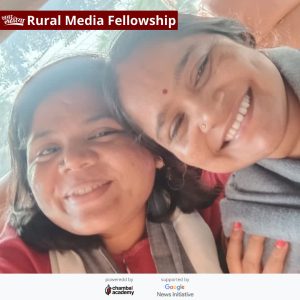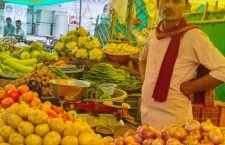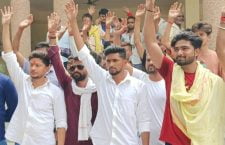A family’s struggle with stigma and loss after a false accusation at a peaceful religious festival.

Once upon a time there was Masjid in this area called Chauraha Masjid which now exists in the memories
This report was submitted as part of the Khabar Lahariya Rural Media Fellowship by Priyanka Tupe and Khabar Lahariya Managing Editor Meera Devi and Edited by Srishti Mehra.
Mahoba, Uttar Pradesh
February 27, 2024
According to a February 2024 Reuters report, anti-Muslim hate speech in India rose by 62% in the second half of 2023 compared to the first six months of the year. The India Hate Lab, a Washington-based research group,documented 668 hate speech incidents targeting Muslims in 2023. Of these, 255 occurred in the first half of the year, while 413 took place in the last six months of 2023. About 75%, or 498, of those incidents took place in states governed by the Bharatiya Janata Party (BJP), according to the report. The states of Maharashtra, Uttar Pradesh and Madhya Pradesh accounted for the most hate speech. In January 2024, the India Hate Lab website became inaccessible in India, though it remains available outside the country. This came shortly after government officials warned the platform’s founder that it might be blocked.
The Quint documented 418 acts of anti-Muslim hate in Uttar Pradesh since Akhlaq’s lynching in 2015. From cow vigilantism, riots, mob lynching to vandalizing places of worships and public appeals of economic boycotts to religion specific demolitions , and the rampant use of social media to spread misinformation about the community.
In September 2019, Khabar Lahariya reported on an incident at the Urs gathering in Mahoba’s Salat village—a day that changed the life of Kallu Shaikh and his family. Four years later, we revisited the family to understand what happened on that fateful day and how it has impacted their lives since.
Survival of Kallu Shaikh’s family
We met Faiza Khatun on a December afternoon in her verandah in Salat village. She lost her husband, Kallu Shaikh, 60, in a road accident in August 2022. However, the family believes that the real cause was the events of August 2019, which led to his depression and ultimately to the accident.

Small temple – 200 meteres away from the Dargah at Modern Temple. People from all faiths used to visit both these religious monuments, we are told.
“He was a very social and kind person,” Faiza shared. “He had been actively involved in organising the Urs for nearly twelve years. People from all faiths gather annually to offer prayers at the dargah.” Urs have been an important part of India’s syncretic culture, with people of all faiths participating. Hundreds of Hindu devotees join the annual Urs near a lake about 10 kilometres from Mahoba district, offering chadar at the dargah and praying. The Urs also features stalls selling cutlery, clothes, food, and other items.

Mahoba’s deserted meat market. Restrictions on meat, halal ban are jeopardizing the lives of muslim meat vendors
“During the Urs of 2019, there were rumours that the food served to Hindu attendees contained meat, and my husband was blamed,” Faiza explained. “Nobody could verify these claims, but the news spread like wildfire. Some people from our village filed an FIR against my husband. The police arrested him, and he spent a week in jail. Local media covered the story, and we were stigmatised by people, even those who knew him well and participated in the annual Urs.” Faiza teared up and paused before continuing, “This had a deep impact on my husband’s mental health.”
Faiza’s family shared that Shaikh felt he was being targeted in an attempt to tarnish his image. He had a good relationship with many Hindu families in the neighbourhood, but even they stopped talking to him after the incident, leaving the family feeling alienated.
“Even after bail, his health continued to deteriorate. He was never the same. I believe that my husband would still be alive today if the traumatic event hadn’t taken such a toll on him. He became very quiet after the incident. I was with him on the bike the day we both had the accident. I survived, but he didn’t. Ultimately, I think it was misinformation that took his life.”
Faiza was joined by her neighbour Muniya, a Hindu, who consoled her and held her hand. “We have been neighbours for over thirty years. We have full faith in this family, and we know chacha (Kallu Shaikh) could never have done what he was accused of. That incident was blown out of proportion by a few miscreants and eventually politicised.”
We spoke with a few other Hindu families in the neighbourhood like Muniya’s, who didn’t wish to go on record but were supportive of Shaikh’s family. However, many others in the village refused to comment on the 2019 incident and the family.
Khushboo, Shaikh’s daughter, remembers her father as a loving person who supported her education. After his death, she had to drop out of school. She wanted to complete her graduation but stopped after the 12th grade. Shaikh’s son, Imran, 18, had to take up a job and earns Rs 5000 a month. Imran and Faiza are now worried about Khushboo’s marriage.
“We need to get her married. A daughter without a father can’t remain unmarried for long as society looks down upon it. We need to save 2-2.5 lakh rupees for her marriage,” says Faiza.
Faiza Khatun was a homemaker but now she sells bangles and cosmetics door-to-door, earning between Rs 150 – 200 a day, sometimes nothing. She is diabetic and has joint pain.
Financial distress isn’t the only problem the Shaikh family faces. Locals who had close relations with the family have cut off ties. “Earlier people used to talk to us, we had good relations with most of them (Hindus). But now when I step out for work, I feel a little anxious and scared but I don’t really have an option.”
Khatun is also concerned that the tradition of Urs, part of India’s syncretic culture, is being destroyed.
“The Urs mela has died out. Earlier, people from all castes and religions used to come,” she said.
Muniya remembers Kallu, “I used to attend the mela every year. Most of the devotees who used to come were Hindu. Chacha wanted everyone to come together and celebrate the festival.”
When we visited the place where Urs used to take place near the modern Talab, there was a small dargah, roughly a 200 square foot structure. The place was mostly deserted as very few people visit because it’s near a forested area. The Urs is still organised every year, but Shaikh’s family doesn’t attend.




